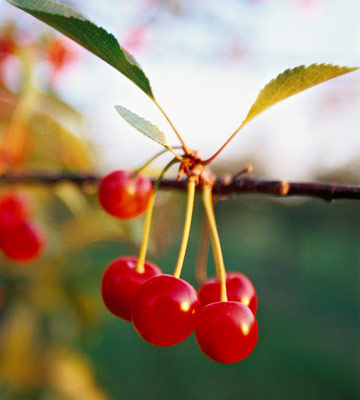






One of the best early-summer afternoons I can remember is eating cherries in the garden with my sister and seeing who could spit a cherry pit the farthest. (Yes, girls can spit, too.) Learn how to grow cherries and you, too, can have spitting contests in the garden plus, make great cherry pies.
So, what will it be -- sweet or tart? Sweet cherries are best for eating fresh and tart varieties make the best pies and preserves, so it's up to you. Fortunately, the guidelines on how to grow cherries -- sweet or tart -- is the same, and both kinds grow in Zones 5-9, although many tart cherries can take the cold down to Zone 4.
Choose a sunny spot for your tree (at least 6 hours of direct sun a day). Cherries grow well in almost any kind of soil, but avoid places where the soil stays soggy for extended periods. Spreading a layer of mulch over the soil around your cherry tree will help it grow better and will help prevent damage from lawn mowers or string trimmers.
Getting fruit from all those flowers on a cherry tree is one of the challenges of growing cherries. Some cherry trees can't pollinate themselves, so you may need two different varieties in the area to get fruit. Because you can't always rely on a neighbor's cherry tree for cross-pollination, if you want sweet cherries it's easiest to select self-pollinating varieties. 'Lapins' and 'Tehranivee' are self-fertile sweet cherries; 'Rainier' needs another variety that blooms at the same time in order to set good fruit. Tart cherries are almost all self-fertile, so don't worry about choosing only one kind or looking for the nearest possible pollinizer. Whatever type you desire, before you make a purchase be sure you check the variety you want to grow to see if it needs another tree to pollinate -- and which varieties are good pollinizer candidates.
Probably the most exciting happening in recent cherry-growing history is the introduction of dwarf rootstock. Unlike many shrubs and perennials, fruit trees often are grafted onto another plant's roots, or rootstock. An interesting feature about fruit trees is that the rootstock controls the size of a tree. So if you graft a 'Rainier' onto three different rootstocks, the resulting trees will grow to three different heights. Other rootstocks will give a cherry tree variety better disease resistance or other features.
Happily, dwarf rootstocks mean no more trees taller than your house that get harvested by the birds long before you can get there! The Gisela rootstock, for example, keeps sweet cherries at only about 10 feet tall instead of the more normal 40 feet. At 10 feet you can easily cover the tree with bird netting to protect your crop.
Growing a cherry tree from rootstock is the preferred method because it can take 10 years or more to get the first fruits from a cherry tree grown from seed. And planting a pit from a cherry purchased from a grocery store or farmer's market isn't recommended either because those cherries tend to be hybrid varieties. If you plant a pit from a hybrid, it won't grow into the same kind of cherry tree -- just like children are not exact replicas of their parents. Additionally, because cherry trees are grafted, one you raise from a pit will grow into a full-size tree that probably doesn't have good disease resistance.
Cherries, unfortunately, are not totally disease-free. Sweet cherries, especially, are susceptible to a disease called brown rot. To help prevent it, provide good air circulation; pruning to leave space between branches will do that. Plus, be scrupulous about cleaning up blossoms, fruit, and leaves that might be affected. Don't leave leaves or old fruit on the ground. The results of brown rot are not pretty: Flowers turn brown and look soggy; fruit becomes mummified. It definitely is something to avoid.
Sulfur is an organic method for brown rot control. You need to spray four times: when the flower buds are pink, when the flowers are open, when the petals fall, and once again about 14 days after that.
Some new research shows that sulfur mixed with a clay product also can help control brown rot on fruit. This is new, so ask at your local nursery for details.
Happily, pruning cherries is relatively straightforward: Do it in the winter after the tree has been in the ground for a year. Follow a pruning regimen that encourages branches that grow in a horizontal fashion and leaves space between them. The Pacific Northwest Extension service recommends pruning annually to remove weak, drooping branches (which usually produce small cherries anyway). Getting rid of these branches every year will help encourage good air flow and reduce disease.
You also want to ensure light penetrates the center of the canopy, so at the top of the tree thin new shoots to a single branch.
Copyright © www.100flowers.win Botanic Garden All Rights Reserved